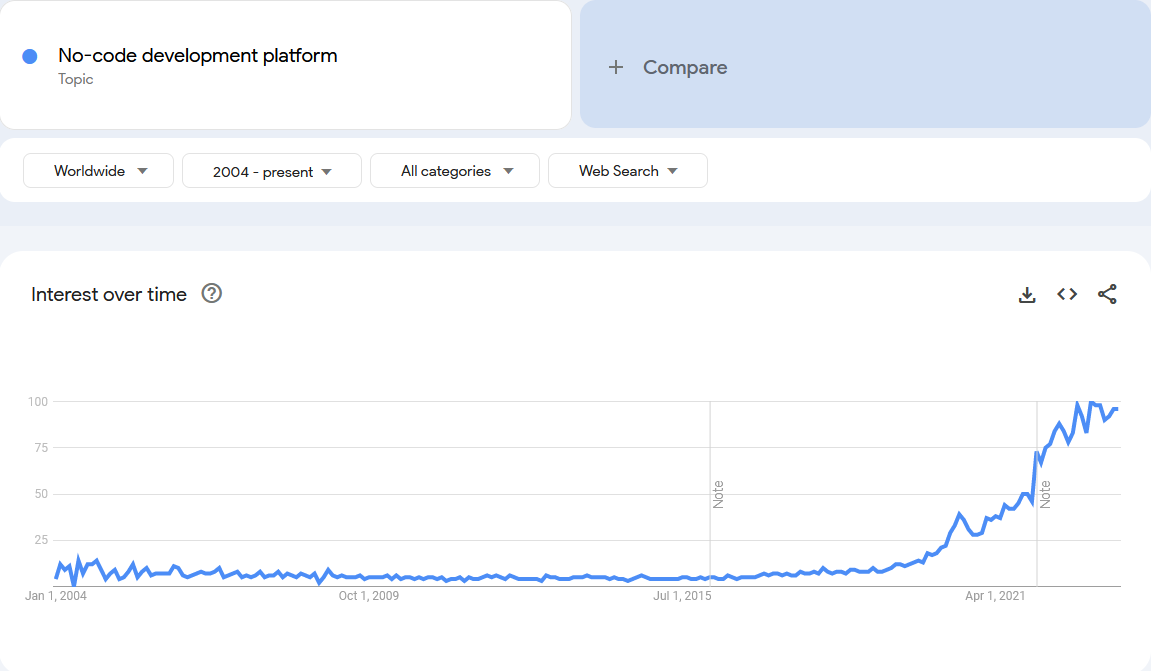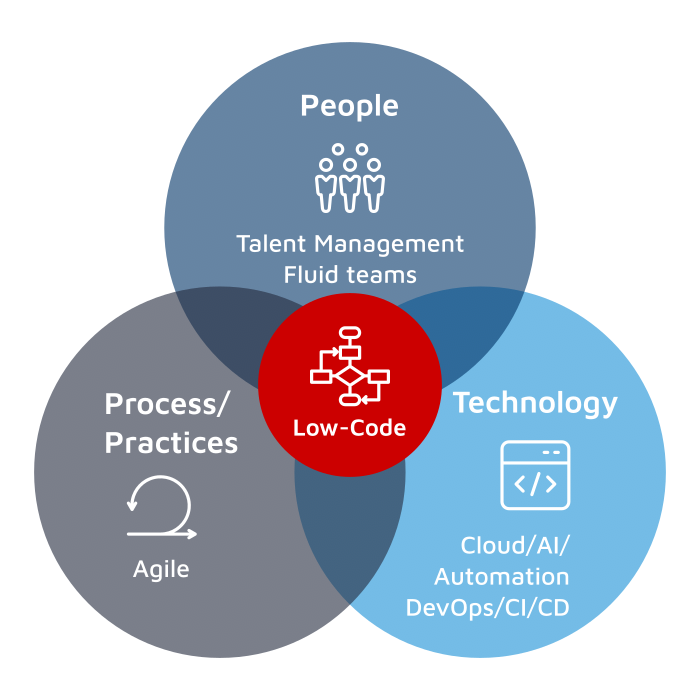Call them Agile Development Platforms because they are not just Low-Code

“If you decide to go Low-Code, it's difficult not to go Agile.” These are the words of a user as reported in the Forrester report Low-Code And Agile: Rocket Fuel For Digital Business[1].
This reference reaffirms how Low-Code concretely implements the practices contemplated in Agile and helps move toward defining platforms such as WebRatio Platform because the “Low-Code” category can be reductive; it only underlines the amount of code necessary for the development of applications, without giving space to the development methodology, Agile, that allows you to put it into practice.
The term Low-Code was born in 2014, and it was clear from the beginning[2] that it was closely connected with the application of Agile methodologies[3]. However, Low-Code seems to be the answer to a term introduced much earlier, namely the “No-Code Development Platform,” of which Google has shown traces of online searches since 2004 (figure 1).

Figure 1 - Source: Google Trends, https://trends.google.com/trends/explore?q=%2Fg%2F11gy7wrlwj&date=all
The term “No-Code” was coined to define the platforms that can also be used by citizen developers—that is, people with no programming experience who approach the IT field because they create solutions without having to write code. It is no coincidence that we find examples of No-Code, such as WordPress, being born in 2003[4], which today is the most used tool for creating websites, even by those who do not know HTML and CSS.
However, if No-Code is for citizen developers, Low-Code is for pro developers and business users, meaning those professionals with experience in analysis and development who, thanks to the time saved through the use of Low-Code platforms such as WebRatio Platform, can focus on business aspects and not on programming.
Is the amount of code to be used with a development platform the only important aspect to users?
Reducing the amount of programmed code is a fundamental aspect of No-Code platforms, even if the total absence of programming can be limiting for pro developers who prefer to adopt Low-Code approaches in which they can integrate the expressive power of traditional programming with the rapidity of visual development.
For a pro developer, however, the decreased requirement for writing Low-Code code allows them to focus on innovation and other aspects such as the functioning of the business, the value generated for users and the company by the applications created and the methodologies and practices to use in development, such as Agile and DevOps.
An analysis of the best relationship between innovation, speed, and quality of development has shown that the Low-Code platforms have the best balance between the different development objectives, compared to the alternatives (prepackaged, No-Code, and High-Code solutions), leaving the expressiveness needed by pro developers but eliminating the repetitive programming of low added value.
What are pro developers looking for in Low-Code platforms?
For Pro Developers the speed and productivity of Low-Code are the tools to empower application delivery. This characteristic of Low-Code encourages decentralized and autonomous development teams[5], which is a main goal of the Agile methodology.
However, becoming Agile is a complex path, as Forrester explains in the report The Global State of Agile 2022: Becoming Proficient Is Like Undertaking a Long Journey to Mars[6]. The analysis shows that 5 years after the start of the transformation toward an Agile approach, only 26% of companies become true experts in the methodology.
The path to becoming Agile is mainly hindered by three factors[7]:
- cultural change, which must take place throughout the company;
- the persistence of a waterfall approach because developers, after adopting Agile practices in one project, sometimes return to working in the waterfall mode for another project; and
- the commitment of executives because it must be the first to invest in and adopt an Agile culture.
Forrester’s analysis[8] also highlights the main technological shortcomings that can hinder the transformation toward Agile:
- lack of integration with DevOps;
- the lack of tools for analyzing the development cycle; and
- the absence of automation systems.
Pro developers are therefore looking for tools that allow them to apply the Agile methodology, which is integrated with the DevOps practices, and automate the repetitive and low-value phases of development, as Low-Code environments like WebRatio Platform do.
The reason why they are not just Low-Code platforms but above all Agile
In light of what has been described, it is clear that Low-Code platforms are useful to pro developers not only because they reduce the programming effort but, above all, because they implement all theories of the Agile methodology into their natural development cycle.
The literature has already defined some platforms as “Agile Development Platforms,” but they are more like tools for project management through the application of the methodology. In the case of Low-Code platforms (e.g., WebRatio Platform), developers can put the methodology directly into practice during the creation of business applications.
Agile is the methodological framework of Low-Code platforms, and the latter acts as a tool for the convergence of the three main factors of digital transformation: people, processes, and technology (figure 2).

Figure 2 - Source: Forrester Report,
When using WebRatio Platform, it is natural to use Agile practices because
- from the viewpoint of the team structure, it makes even small teams of developers (so-called squads or tribes) autonomous and very productive;
- from the viewpoint of work organization, it offers the possibility of making very frequent releases (sprints) of small batches or MVPs, to be prepared to adapt to the development of epics and user stories;
- from the viewpoint of the software product’s architecture, it allows for the modularization and creation of composable applications, thanks to microservices and APIs;
- increased productivity leaves time to focus on people and interactions;
- the need for documentation necessary for development decreases because it is replaced by visual models that act as a common language between business and IT;
- seeing the results in real-time makes collaboration with customers easier because they can immediately see a working application and follow its evolution; and
- greater collaboration and immediate feedback lead to greater responsiveness to change, even with poorly defined and very dynamic plans.
Agile since 2001
The term No-Code was born in 2004, whereas Low-Code was coined in 2014. Since 2001, WebRatio has been proposing a visual design and development technology, which over the years has been defined in many different ways: computer-aided software engineering, model-driven development, rapid application development, and, today, Low-Code development.
Thanks to the characteristics of WebRatio Platform, we have always offered the clear advantages of visual development, such as greater collaboration between business and IT, or the possibility of developing with uncertain or not-yet-defined requirements, which are the foundations of the Agile methodology.
However, one factor has always been central: responsiveness to change. WebRatio Platform is the development environment that has supported the change in national and international client companies that have followed us over the years in the adoption of technological innovations such as BPM, Cloud, Mobile, IoT, microservices, and APIs.
Our technology is nothing more than the expression of a culture of propensity for change that we have always promoted, and you can provide any definition you want for an approach that sees the future as a possibility.
Find out about DevOps and Low-Code >
Sources
[3] https://www.forbes.com/sites/forbestechcouncil/2021/01/07/what-is-low-code-development/
Latest Stories
CIO priority for 2026: boosting productivity, including Low-Code
Customised AI in 1 Month with Low-Code: AI Mind by OriginalSkills
WebRatio Platform 9.3.0: more autonomy, more productivity, more control – and a new look for your apps
Tag
AllArtificial Intelligence - AI
BPA Development
BPM Software
Customer
Digital Transformation
Distribution & Retail
Energy & Utilities
Enterprise Applications
Finance & Insurance
IoT
LinkedIn Live
Low-code
Manufacturing
Mobile Development
Modernization
Partner
Shadow IT
Travel & Transportation
Web Development
WebRatio Platform